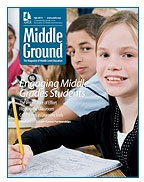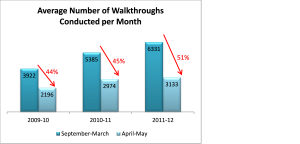At their core, classroom observations should be about coaching, building up professional practice, and supporting better outcomes for students. Principals should use classroom observation data to enrich conversations during professional learning community meetings, individual teacher coaching conferences, and staff meetings. When large samples of student data are available, school leaders can disaggregate the data by age, content area, or other categories to enable powerful analysis of the data’s meaning and uses. This, combined with other evidence, can be used to support school improvement goals, collaborative planning, professional development planning, and a common understanding of what quality pedagogy looks like. Principals who do this well can help their teachers
make great gains in teaching and learning.
We’re sometimes asked by principals and district leaders who are interested in Power Walkthrough® for more information about how the system ties in with research-informed instructional practices and good classroom observation protocols and purposes.
The Power Walkthrough system supports best practice by using a carefully designed template of observable elements based on the best understanding of modern pedagogy, with indicators of research-informed classroom environmental factors, instructional strategies, learning taxonomies, technology applications, evidence of learning, and student interview responses. The template is customizable, so that if a school wants to focus on formative assessment or collaborative learning, they can do so by adding or substituting observation elements. We recommend not adding too much to the observation template, so that it doesn’t turn into a teacher evaluation tool and take too long to conduct. If individual observations take more than 3-5 minutes to conduct, principals won’t
be able to visit enough classrooms for the data to be valid and reliable.
Validity and reliability of data relies not only on a sufficient sample size, but also on the skill of the observer. Becoming an efficient, skilled, and astute observer of teaching and learning takes quality training, practice, and collaborative reflection between observers. School leaders don’t have to be experts in all content areas to conduct good observations, but they do have to be highly knowledgeable in pedagogy and be a keen observer of student learning evidence. The Power Walkthrough templates help principals by providing cues, “look-fors,” and a common nomenclature.
Templates and lists provide structure and allow for statistical analysis, but they don’t preclude the principal from observing other factors in the classroom, interviewing students, or recording descriptive notes. In fact, Power
Walkthrough observations are designed to end with student interviews to gather student perspectives on what they’re trying to learn and why they’re learning it, to see if they fully comprehend the objectives of the lesson. Answers such as “we’re learning math because we have a test on Friday” aren’t good enough. A great
answer would be something like, “we’re learning how to graph polynomials because they can be used to model how some things work in nature like the shape a stream of water takes when it’s shot out of a fountain or the path of a
basketball when you shoot a free throw.”
In the end it’s not about the instrument itself, but how it’s applied. Depending on the goals of school leadership, Power Walkthrough can be used either for typical data collection purposes or innovative change. We encourage instructional leaders to collaborate with each other and their teachers to learn from the data together. Teachers will take ownership of the data’s meaning if they are allowed to find it themselves rather than using a top-down approach of dictating to them what the data means. If used regularly and collaboratively, Power Walkthrough data can provide a wealth of professional development experiences for all educators, both on a daily basis and as part of a whole school improvement effort.
We hope this explains a little more about how Power Walkthrough supports good classroom observation practices and instructional improvement.
![DisplayThumbnailNoDB[1] 6a010536aec25c970b0192ab65b429970d](https://www.mcrel.org/wp-content/uploads/2016/06/6a010536aec25c970b0192ab65b429970d.jpg)


 But in examining our clients’ data, we often see a decrease in the number of walkthroughs during April and May. Walkthroughs should be an integral part of the school culture and part of the normal routine in which teachers and students are comfortable with administrators in the classroom. If we know and understand the importance of walkthroughs, why is there such a large drop-off in how many are done during the last quarter of the school year?
But in examining our clients’ data, we often see a decrease in the number of walkthroughs during April and May. Walkthroughs should be an integral part of the school culture and part of the normal routine in which teachers and students are comfortable with administrators in the classroom. If we know and understand the importance of walkthroughs, why is there such a large drop-off in how many are done during the last quarter of the school year?